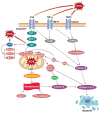"Double-edged sword" effect of reactive oxygen species (ROS) in tumor development and carcinogenesis
- PMID: 37449744
- PMCID: PMC10669002
- DOI: 10.33549/physiolres.935007
"Double-edged sword" effect of reactive oxygen species (ROS) in tumor development and carcinogenesis
Abstract
Reactive oxygen species (ROS) are small reactive molecules produced by cellular metabolism and regulate various physiological and pathological functions. Many studies have shown that ROS plays an essential role in the proliferation and inhibition of tumor cells. Different concentrations of ROS can have a "double-edged sword" effect on the occurrence and development of tumors. A certain concentration of ROS can activate growth-promoting signals, enhance the proliferation and invasion of tumor cells, and cause damage to biomacromolecules such as proteins and nucleic acids. However, ROS can enhance the body's antitumor signal at higher levels by initiating oxidative stress-induced apoptosis and autophagy in tumor cells. This review analyzes ROS's unique bidirectional regulation mechanism on tumor cells, focusing on the key signaling pathways and regulatory factors that ROS affect the occurrence and development of tumors and providing ideas for an in-depth understanding of the mechanism of ROS action and its clinical application.
Conflict of interest statement
There is no conflict of interest.
Figures




Similar articles
-
Reactive Oxygen Species and Targeted Therapy for Pancreatic Cancer.Oxid Med Cell Longev. 2016;2016:1616781. doi: 10.1155/2016/1616781. Epub 2016 Jan 3. Oxid Med Cell Longev. 2016. PMID: 26881012 Free PMC article. Review.
-
Redox regulation in cancer: a double-edged sword with therapeutic potential.Oxid Med Cell Longev. 2010 Jan-Feb;3(1):23-34. doi: 10.4161/oxim.3.1.10095. Oxid Med Cell Longev. 2010. PMID: 20716925 Free PMC article. Review.
-
The double-edged roles of ROS in cancer prevention and therapy.Theranostics. 2021 Mar 4;11(10):4839-4857. doi: 10.7150/thno.56747. eCollection 2021. Theranostics. 2021. PMID: 33754031 Free PMC article. Review.
-
MAP17 and the double-edged sword of ROS.Biochim Biophys Acta. 2012 Aug;1826(1):44-52. doi: 10.1016/j.bbcan.2012.03.004. Epub 2012 Mar 23. Biochim Biophys Acta. 2012. PMID: 22465409 Review.
-
Reactive Oxygen Species and Antioxidants in Carcinogenesis and Tumor Therapy.Biochemistry (Mosc). 2020 Oct;85(10):1254-1266. doi: 10.1134/S0006297920100132. Biochemistry (Mosc). 2020. PMID: 33202210 Review.
Cited by
-
Fabrication of zinc oxide nanoparticles using Ruellia tuberosa leaf extract induces apoptosis through P53 and STAT3 signalling pathways in prostate cancer cells.Open Life Sci. 2025 Jul 11;20(1):20251121. doi: 10.1515/biol-2025-1121. eCollection 2025. Open Life Sci. 2025. PMID: 40667484 Free PMC article.
-
Oxidative Stress and Redox-Dependent Pathways in Cholangiocarcinoma.Antioxidants (Basel). 2023 Dec 22;13(1):28. doi: 10.3390/antiox13010028. Antioxidants (Basel). 2023. PMID: 38247453 Free PMC article. Review.
-
Diquat Induces Cell Death and dopamine Neuron Loss via Reactive Oxygen Species Generation in Caenorhabditis elegans.Environ Sci Technol. 2025 Jan 14;59(1):152-162. doi: 10.1021/acs.est.4c07783. Epub 2025 Jan 2. Environ Sci Technol. 2025. PMID: 39745087 Free PMC article.
-
Lifting the veil on tumor metabolism: A GDH1-focused perspective.iScience. 2025 May 3;28(6):112551. doi: 10.1016/j.isci.2025.112551. eCollection 2025 Jun 20. iScience. 2025. PMID: 40487432 Free PMC article. Review.
-
A manganese metabolism-related gene signature stratifies prognosis and immunotherapy efficacy in kidney cancer.Discov Oncol. 2025 Jul 1;16(1):1242. doi: 10.1007/s12672-025-03050-9. Discov Oncol. 2025. PMID: 40591061 Free PMC article.
References
-
- Rincheval V, Bergeaud M, Mathieu L, Leroy J, Guillaume A, Mignotte B, Le Floch N, Vayssière JL. Differential effects of Bcl-2 and caspases on mitochondrial permeabilization during endogenous or exogenous reactive oxygen species-induced cell death: a comparative study of H2O2, paraquat t-BHP, etoposide, TNF-α-induced cell death. Cell Biol Toxicol. 2012;28:239–253. doi: 10.1007/s10565-012-9219-9. - DOI - PubMed
